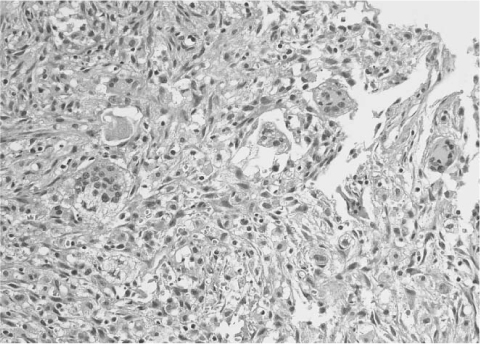J Korean Soc Radiol.
2010 Jan;62(1):11-15. 10.3348/jksr.2010.62.1.11.
Multiple Synchronous Central Giant Cell Granulomas of the Maxillofacial Region: A Case Report
- Affiliations
-
- 1Department of Radiology, Pusan National University Hospital, College of Medicine, Pusan National University. Korea. hakjink@pusan.ac.kr
- KMID: 2208988
- DOI: http://doi.org/10.3348/jksr.2010.62.1.11
Abstract
- Multifocal central giant cell granulomas (CGCG) in the maxillofacial region are suggestive of systemic disease such as hyperparathyroidism or an inherited syndrome such as Noonan-like multiple giant cell lesion syndrome. Only 5 cases of multifocal CGCGs in the maxillofacial region without any concomitant systemic disease have currently been reported. We report here on an unusual case of 17-year-old man who presented with multifocal CGCGs of the bilateral posterior mandible and right maxilla and he was without any concomitant systemic disease.
MeSH Terms
Figure
Reference
-
1. Curtis NJ, Walker DM. A case of aggressive multiple metachronous central giant cell granulomas of the jaws: differential diagnosis and management options. Int J Oral Maxillofac Surg. 2005; 34:806–808.2. Murphey MD, Nomikos GC, Flemming DJ, Gannon FH, Temple HT, Kransdorf MJ. Imaging of giant cell tumor and giant cell reparative granuloma of bone: radiologic-pathologic correlation. Radiographics. 2001; 21:1283–1309.3. Edwards PC, Fox J, Fantasia JE, Goldberg J, Kelsch RD. Bilateral central giant cell granulomas of the mandible in an 8-year-old girl with Noonan syndrome (Noonan-like/multiple giant cell lesion syndrome). Oral Surg Oral Med Oral Pathol Oral Radiol Endod. 2005; 99:334–340.4. Junquera LM, Lupi E, Lombardia E, Fresno MF. Multiple and synchronodus peripheral giant cell granulomas of the gums. Ann Otol Rhinol Laryngol. 2002; 111:751–753.5. Martins WD, de Oliveira Ribas M, Braosi AP, Machado MA, Lima AA. Multiple giant cell lesions of the maxillofacial skeleton. J Oral Maxillofac Surg. 2007; 65:1250–1253.6. Morris JM, Lane JI, Witte RJ, Thompson DM. Giant cell reparative granuloma of the nasal cavity. AJNR Am J Neuroradiol. 2004; 25:1263–1265.7. Smith PG, Marrogi AJ, Delfino JJ. Multifocal central giant cell lesions of the maxillofacial skeleton: a case report. J Oral Maxillofac Surg. 1990; 48:300–305.8. Cakirer S. Quiz case. Giant cell reparative granuloma of the maxillary sinus. Eur J Radiol. 2002; 44:24–27.
- Full Text Links
- Actions
-
Cited
- CITED
-
- Close
- Share
- Similar articles
-
- Central giant cell granuloma in mandible: report of a case
- Central giant cell lesion of the mandible in a 2-year old girl
- Central giant cell granuloma and cementifying fibroma occurring in the same lesion of right mandibular body: a case report
- Synchronous thyroid carcinoma and squamous cell carcinoma: A case report
- A Case of a Central Giant Cell Granuloma in the Right Zygomatic Bone




